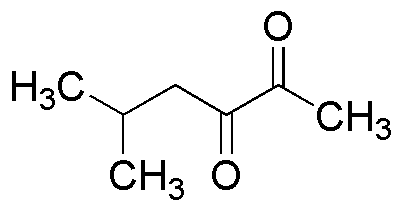5-Methyl-2,3-hexanedione is widely utilized in research focused on:
- Flavoring and Fragrance Industry: This compound is used as a flavoring agent in food products, providing a sweet and buttery taste that enhances the overall flavor profile.
- Pharmaceuticals: It serves as an intermediate in the synthesis of various pharmaceuticals, helping to create compounds with therapeutic effects.
- Polymer Production: The compound is employed in the production of specialty polymers, contributing to materials with unique properties such as flexibility and durability.
- Analytical Chemistry: It is utilized as a standard in analytical methods, aiding researchers in the quantification and identification of other chemical substances.
- Cosmetics: This chemical is incorporated into cosmetic formulations for its stabilizing properties, enhancing product performance and shelf life.
General Information
Properties
Safety and Regulations
Applications
5-Methyl-2,3-hexanedione is widely utilized in research focused on:
- Flavoring and Fragrance Industry: This compound is used as a flavoring agent in food products, providing a sweet and buttery taste that enhances the overall flavor profile.
- Pharmaceuticals: It serves as an intermediate in the synthesis of various pharmaceuticals, helping to create compounds with therapeutic effects.
- Polymer Production: The compound is employed in the production of specialty polymers, contributing to materials with unique properties such as flexibility and durability.
- Analytical Chemistry: It is utilized as a standard in analytical methods, aiding researchers in the quantification and identification of other chemical substances.
- Cosmetics: This chemical is incorporated into cosmetic formulations for its stabilizing properties, enhancing product performance and shelf life.
Documents
Safety Data Sheets (SDS)
The SDS provides comprehensive safety information on handling, storage, and disposal of the product.
Product Specification (PS)
The PS provides a comprehensive breakdown of the product’s properties, including chemical composition, physical state, purity, and storage requirements. It also details acceptable quality ranges and the product's intended applications.
Certificates of Analysis (COA)
Search for Certificates of Analysis (COA) by entering the products Lot Number. Lot and Batch Numbers can be found on a product’s label following the words ‘Lot’ or ‘Batch’.
*Catalog Number
*Lot Number
Certificates Of Origin (COO)
This COO confirms the country where the product was manufactured, and also details the materials and components used in it and whether it is derived from natural, synthetic, or other specific sources. This certificate may be required for customs, trade, and regulatory compliance.
*Catalog Number
*Lot Number
Safety Data Sheets (SDS)
The SDS provides comprehensive safety information on handling, storage, and disposal of the product.
DownloadProduct Specification (PS)
The PS provides a comprehensive breakdown of the product’s properties, including chemical composition, physical state, purity, and storage requirements. It also details acceptable quality ranges and the product's intended applications.
DownloadCertificates of Analysis (COA)
Search for Certificates of Analysis (COA) by entering the products Lot Number. Lot and Batch Numbers can be found on a product’s label following the words ‘Lot’ or ‘Batch’.
*Catalog Number
*Lot Number
Certificates Of Origin (COO)
This COO confirms the country where the product was manufactured, and also details the materials and components used in it and whether it is derived from natural, synthetic, or other specific sources. This certificate may be required for customs, trade, and regulatory compliance.


